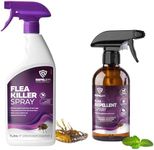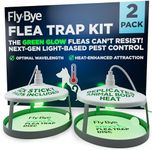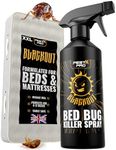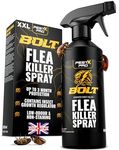Buying Guide for the Best Home Flea Sprays
Choosing the right home flea spray is crucial for effectively managing flea infestations in your living space. Fleas can be a nuisance and pose health risks to both pets and humans. When selecting a flea spray, consider factors such as the size of the area you need to treat, the severity of the infestation, and any specific needs or sensitivities of your household. Understanding the key specifications of flea sprays will help you make an informed decision that best suits your situation.Active IngredientsActive ingredients in flea sprays are the chemicals responsible for killing fleas and preventing their return. Common active ingredients include pyrethrins, permethrin, and insect growth regulators (IGRs). Pyrethrins and permethrin are effective at killing adult fleas, while IGRs prevent flea eggs and larvae from developing. If you have pets or children, you may want to choose a spray with natural ingredients or one specifically labeled as safe for use around them. Consider the severity of your flea problem; stronger chemicals may be necessary for severe infestations.
Coverage AreaCoverage area refers to the amount of space a flea spray can effectively treat. This is important because you need to ensure that the spray can cover the entire area where fleas are present. Sprays come in different sizes, from small bottles for spot treatments to larger containers for whole-house applications. If you have a large home or multiple rooms affected, you may need a spray with a larger coverage area. Conversely, for minor infestations or smaller spaces, a smaller bottle may suffice.
Residual EffectResidual effect is the duration for which a flea spray continues to kill fleas after application. This is crucial for preventing re-infestation. Some sprays offer immediate results but have a short residual effect, while others may take longer to work but provide protection for weeks. If you want long-term protection, look for sprays with a longer residual effect. Consider your lifestyle and how often you can reapply the spray; a longer residual effect may be beneficial if frequent application is inconvenient.
SafetySafety is a key consideration, especially if you have pets, children, or individuals with allergies in your home. Some flea sprays contain harsh chemicals that can be harmful if inhaled or ingested. Look for sprays that are labeled as safe for use around pets and children, or opt for natural or organic options. If anyone in your household has sensitivities, prioritize sprays with minimal or no harsh chemicals. Always follow the manufacturer's instructions for safe application.
Ease of UseEase of use refers to how simple it is to apply the flea spray effectively. Some sprays come in aerosol cans, while others are pump sprays or require mixing. Consider how comfortable you are with the application process; aerosol sprays are generally easier to use and require less effort. If you prefer a straightforward application, choose a spray with a user-friendly design. Additionally, check if the spray requires any special equipment or protective gear for application.


















